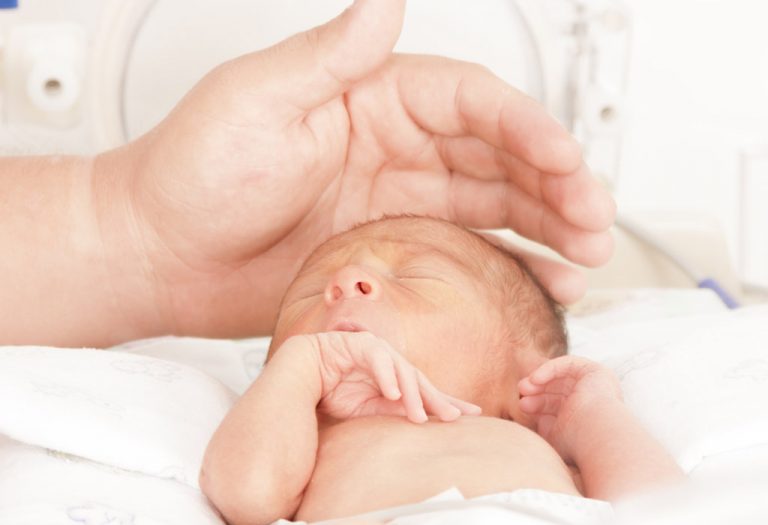Intrauterine Growth Restriction (IUGR) – Causes and Treatment

Intrauterine growth restriction (IUGR) is a condition where the growth of the foetus is restricted and the foetus is smaller than 90% of foetuses of the same age. Babies in this condition are also known as ‘small for gestational age,’ and this condition occurs in up to 10-15% of pregnancies (1). It could be due to any or a number of factors, such as genetic, fetal, maternal, or placental. While the term or the acronym sounds worrying, IUGR babies may still be born healthy if specific treatments and strategies are applied to prevent the IUGR with the help of medical professionals.
What Is Intrauterine Growth Restriction?
IUGR is a condition where the growth of the baby is slow while in the mother’s womb. It is also known as Intrauterine Growth Retardation or Foetal Growth Restriction. According to the Cleveland Clinic, if your baby has been diagnosed with IUGR, it indicates that their fetal weight falls below the 10th percentile for their gestational age or that their birth weight is under 5 pounds, 8 ounces (2) (3). Thus, being below the 10th percentile signifies that the weight of the fetus is less than 90 per cent of all other developing babies at the same gestational age.
Types
There are three types of intrauterine growth restriction: Symmetrical IUGR, Asymmetrical IUGR, and mixed (4).
1. Symmetrical IUGR
Symmetrical IUGR, also known as Primary IUGR, comprises 20-25% of cases of IUGR (5). In this condition, the baby displays overall restriction in growth and all internal organs are reduced in size.
2. Asymmetrical IUGR
Asymmetrical IUGR, also known as Secondary IUGR, is when the baby’s head and brain are of normal size while the rest of the baby’s body is comparatively small. This condition is more difficult to diagnose and can go unnoticed until the third trimester.
3. Mixed IUGR
Mixed IUGR is usually seen in low or middle-income countries where the risk of IUGR is high.
Causes of IUGR
IUGR or fetal growth restriction may be caused by various factors, ranging from the medical history of the parents to pregnancy complications. The following are some of the causes of IUGR (6) (4):
- Some medical conditions are known to cause IUGR. The chief causes among these are chronic hypertension, problems with kidney function, heart disease, lung disorders, Antiphospholipid Antibody Syndrome, sickle cell disease, and advanced diabetes.
- If there are abnormalities in the placenta or it is too small, it will be ineffective in providing the required nutrients to the baby and in removing waste from the baby’s blood, resulting in IUGR.
- Abnormalities, such as anencephaly (absence of a large part of the brain), Down syndrome, kidney defects, chromosomal defects, etc., are also known causes of intrauterine growth restriction.
- Mothers carrying twins or triplets may also suffer from IUGR.
- If the mother has a history of alcohol and drug abuse or is a smoker, the risk of IUGR increases.
- Diseases such as rubella, syphilis and toxoplasmosis are carried by the mother.
- If the mother is malnourished during pregnancy, the growth of the baby will be inhibited.
- Anticonvulsant drugs administered to mothers during pregnancy can also be a cause.
- If the mother is underweight, it can have a direct impact on the growth of the unborn child.
- A malfunction in the umbilical cord may also cause IUGR.
- It could be genetic. As IUGR can happen any time during the pregnancy term, experts are of the opinion that IUGR occurring in babies at the beginning of a pregnancy could be linked to the genetic factor or an issue with the umbilical cord or placenta (5).
What Are the Symptoms of Intrauterine Growth Restriction?
While the small size of the baby may be indicative of the condition, it is important to note that not all babies that are born small have IUGR. Thus, it is essential to learn about the IUGR signs and symptoms.
The primary symptom of IUGR is the ‘small for gestational age’ (SGA) trait. A baby is considered an SGA baby when the estimated age of the baby is below the 10th percentile. i.e. if the estimated weight of the baby is less than 90% of the babies of the same gestational age.
In case of IUGR, the length from the mother’s pubic bone to the apex of the uterus will be less than expected for the baby’s gestational age. This measurement is referred to as the uterine fundal height (7). The baby may also appear thin, pale, have loose, dry skin, or just be small in overall size. Also, the umbilical cord is thin and dull instead of thick and shiny.
Diagnosis and Tests for IUGR
There are various methods that doctors have at their disposal to check the estimated size of babies in the womb. One of the commonest test procedures employed is to measure the distance from the top of the mother’s uterus to her pubic bone. 20 weeks into the pregnancy, this measurement in centimetres should roughly correspond with the number of weeks of pregnancy. If the measurement is lower than the expected number, it is a strong indicator that the baby is not growing in the usual way.
There are also other tests that can be conducted to check for IUGR, including (8):
1. Ultrasound
Ultrasound is an IUGR radiology method that creates an image of the baby in the womb by the use of sound waves. An ultrasound allows the doctor to see the baby in the womb and take measurements of the baby’s head and abdomen. These measurements are then compared to growth charts for an estimate of the baby’s weight. This method may also be used to detect the amount of amniotic fluid in the uterus. Any volume of amniotic fluid that is lower than necessary may be indicative of IUGR.
2. Doppler Flow
This is a method of measuring the flow of blood, its amount, and the speed at which blood flows through blood vessels. Doppler in IUGR can measure the flow of blood in the umbilical cord and the blood vessels in the baby’s developing brain.
Risk Factors Associated With IUGR
According to MedlinePlus, there are several factors that may cause IUGR. It has been observed that mothers carrying twins and triplets run a risk, as do mothers who have had an IUGR pregnancy previously. It has also been observed that underweight women or women with poor appetites also face the risk. Women with lung disease, heart ailments, and blood and kidney disorders are vulnerable, too (9).
Complications of IUGR
Some complications that can arise because of IUGR include (10):
- The small size of the baby means that it cannot receive sufficient oxygen and nutrients.
- A C-section may have to be performed since the baby may not be able to withstand the rigours of natural birth.
- An underweight baby is prone to infections and jaundice.
- The baby may find it difficult to feed.
- The baby may not be able to maintain his body temperature.
- In some cases, preterm delivery.
- A weak immune system which can make the baby vulnerable to infection.
- Increased probability of stillbirth in case of extremely low birth weight.
- Babies born with neurological disorders due to extremely low birth weight.
- Babies with hampered renal function, again due to extremely low weight.
Effects of IUGR
Certain effects of an IUGR pregnancy are listed below:
- Foetuses with IUGR may, in some cases, display altered cardiac function.
- It may have a direct impact on the ability of the foetus to acquire genetic growth potential on account of nutritional deprivation.
- Insufficient nutrition can lead to the death of the foetus.
- IUGR foetuses are in grave danger of perinatal asphyxia, which affects various organs.
- Infant mortality is high among IUGR babies.
- IUGR foetuses may sometimes also suffer from retarded neurological development.
IUGR Treatment and Management
The Tommy’s suggests certain precautions can be taken to manage IUGR, such as (11):
- Do not consume alcohol, tobacco, or recreational drugs.
- Ensure a healthy diet, avoiding such foods as mentioned by your doctor.
- Do not miss out on prenatal appointments.
- Check prescribed medications for side effects.
- Appropriate rest could help IUGR babies through the pregnancy.
While there are no specific treatments or medications for women with IUGR pregnancies, there are some treatments that can help:
- The mother may be administered medication to improve blood flow.
- The mother can be given timely treatment for any other complications she may have, which could also be contributing to IUGR.
- Intravenous medications, steroids and nutrients can be administered to help the foetus mature faster.
Prevention of IUGR
Certain preventive measures that can be taken are:
- If problems with the foetus can be detected earlier, they can be treated earlier. It is essential to attend all prenatal appointments.
- If the baby is not moving enough or kicking enough, visit your doctor, as it could indicate a problem.
- All medication consumed by the mother should be checked, as some medications that the mother may be taking for another complication could pose a threat to the baby.
- Eat healthily and keep away from alcohol, tobacco, and drugs.
What to Expect After Delivery
IUGR in pregnancy is not the end of the world, as most IUGR babies would catch up with other children after birth. In case of severe IUGR, babies may face complications that preterm babies face, but can also live a normal life once they are around the age of three. While IUGR is a risky condition, the advances in modern medicine and improved knowledge of the condition today allow us to address most of the problems associated with it.
FAQs
1. How are IUGR and small for gestational age (SGA) different from each other?
Although small for gestational age (SGA) and IUGR sound similar, they have a subtle difference. IUGR basically emphasises the stress a fetus experiences during pregnancy. SGA, on the other hand, focuses on the size of the baby, and being classified as SGA does not necessarily indicate any developmental problems.
2. What should I do if my baby bump is not increasing in size?
Since every pregnancy progresses uniquely, it is advised not to compare the size of your baby bump to anyone else’s. If you are worried about the bump size, consult your doctor for verified guidance (11).
3. Does fetal growth restriction (FGR) affect subsequent pregnancies?
The risk of fetal growth restriction in your baby increases in subsequent pregnancies if you have a history of IUGR (11).
4. Do babies with IUGR require long-term pediatric follow-ups?
The potential health issues that come with IUGR can lead your baby to have long-term pediatric follow-up care.
IUGR can happen at any time during the pregnancy (8). If your baby is diagnosed with IUGR, your doctor will recommend frequent monitoring and tailored appointments to manage any adverse effects.
References/Resources:
2. Cleveland Clinic – Intrauterine Growth Restriction
4. Nemours KidsHealth – Intrauterine Growth Restriction (IUGR)
5. PubMed Central – Intrauterine Growth Restriction: Antenatal and Postnatal Aspects
6. Columbia University – Intrauterine Growth Restriction (Fetal Growth Abnormality)
7. Mount Sinai – Intrauterine growth restriction
8. Children’s Minnesota – Intrauterine growth restriction (IUGR) care
9. MedlinePlus – Intrauterine growth restriction
11. Tommy’s – Fetal growth restriction (Intrauterine growth restriction)
Also Read:
Foetal Development
Increase Fetal Weight During Pregnancy
Helping Your Premature Baby Gain Weight
Identify Healthy and Unhealthy Baby in Womb
Was This Article Helpful?
Parenting is a huge responsibility, for you as a caregiver, but also for us as a parenting content platform. We understand that and take our responsibility of creating credible content seriously. FirstCry Parenting articles are written and published only after extensive research using factually sound references to deliver quality content that is accurate, validated by experts, and completely reliable. To understand how we go about creating content that is credible, read our editorial policy here.























